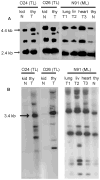The frequency of occurrence and nature of recombinant feline leukemia viruses in the induction of multicentric lymphoma by infection of the domestic cat with FeLV-945
- PMID: 20451235
- PMCID: PMC2879462
- DOI: 10.1016/j.virol.2010.04.011
The frequency of occurrence and nature of recombinant feline leukemia viruses in the induction of multicentric lymphoma by infection of the domestic cat with FeLV-945
Abstract
During feline leukemia virus (FeLV) infection in the domestic cat, viruses with a novel envelope gene arise by recombination between endogenous FeLV-related elements and the exogenous infecting species. These recombinant viruses (FeLV-B) are of uncertain disease association, but have been linked to the induction of thymic lymphoma. To assess the role of FeLV-B in the induction of multicentric lymphoma and other non-T-cell disease, the frequency of occurrence and nature of FeLV-B were examined in diseased tissues from a large collection of FeLV-infected animals. Diseased tissues were examined by Southern blot and PCR amplification to detect the presence of FeLV-B. Further analysis was performed to establish the recombination junctions and infectivity of FeLV-B in diseased tissues. The results confirmed the frequent association of FeLV-B with thymic lymphoma but showed infrequent generation, low levels and lack of infectivity of FeLV-B in non-T-cell diseases including multicentric lymphoma.
Figures




Similar articles
-
Transduction of Notch2 in feline leukemia virus-induced thymic lymphoma.J Virol. 1996 Nov;70(11):8071-80. doi: 10.1128/JVI.70.11.8071-8080.1996. J Virol. 1996. PMID: 8892932 Free PMC article.
-
Subtle mutational changes in the SU protein of a natural feline leukemia virus subgroup A isolate alter disease spectrum.J Virol. 2005 Feb;79(3):1351-60. doi: 10.1128/JVI.79.3.1351-1360.2005. J Virol. 2005. PMID: 15650161 Free PMC article.
-
Recombinant feline leukemia virus (FeLV) variants establish a limited infection with altered cell tropism in specific-pathogen-free cats in the absence of FeLV subgroup A helper virus.Vet Pathol. 1999 Mar;36(2):91-9. doi: 10.1354/vp.36-2-91. Vet Pathol. 1999. PMID: 10098636
-
Endogenous env elements: partners in generation of pathogenic feline leukemia viruses.Virus Genes. 1995;11(2-3):147-61. doi: 10.1007/BF01728655. Virus Genes. 1995. PMID: 8828142 Review.
-
Advances in understanding molecular determinants in FeLV pathology.Vet Immunol Immunopathol. 2008 May 15;123(1-2):14-22. doi: 10.1016/j.vetimm.2008.01.008. Epub 2008 Jan 19. Vet Immunol Immunopathol. 2008. PMID: 18289704 Free PMC article. Review.
Cited by
-
Phylogenetic identification of feline leukemia virus A and B in cats with progressive infection developing into lymphoma and leukemia.Virus Res. 2023 May;329:199093. doi: 10.1016/j.virusres.2023.199093. Epub 2023 Mar 20. Virus Res. 2023. PMID: 36924831 Free PMC article.
-
The surface glycoprotein of a natural feline leukemia virus subgroup A variant, FeLV-945, as a determinant of disease outcome.Vet Immunol Immunopathol. 2011 Oct 15;143(3-4):221-6. doi: 10.1016/j.vetimm.2011.06.015. Epub 2011 Jun 12. Vet Immunol Immunopathol. 2011. PMID: 21764142 Free PMC article.
-
Viral determinants of FeLV infection and pathogenesis: lessons learned from analysis of a natural cohort.Viruses. 2011 Sep;3(9):1681-98. doi: 10.3390/v3091681. Epub 2011 Sep 9. Viruses. 2011. PMID: 21994802 Free PMC article. Review.
-
Feline Leukemia Virus (FeLV) Endogenous and Exogenous Recombination Events Result in Multiple FeLV-B Subtypes during Natural Infection.J Virol. 2021 Aug 25;95(18):e0035321. doi: 10.1128/JVI.00353-21. Epub 2021 Aug 25. J Virol. 2021. PMID: 34232703 Free PMC article.
References
-
- Bechtel MK, Mathes LE, Hayes KA, Phipps AJ, Roy-Burman P. In vivo evolution and selection of recombinant feline leukemia virus species. Virus Res. 1998;54(1):71–86. - PubMed
-
- Chandhasin C, Lobelle-Rich P, Levy LS. Feline leukaemia virus LTR variation and disease association in a geographical and temporal cluster. J Gen Virol. 2004;85(Pt 10):2937–42. - PubMed
Publication types
MeSH terms
Substances
Grants and funding
LinkOut - more resources
Full Text Sources
Medical
Miscellaneous

